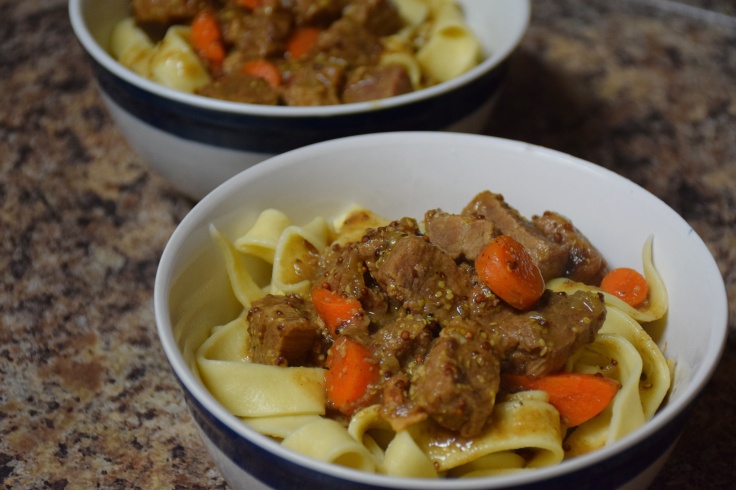
If you’re glancing at this recipe (and skipping over this section of commentary like I usually do until I’m sure the recipe and its ingredients interest me!), you might be a little concerned about ALL THAT MUSTARD. It certainly does seem like a lot, but don’t worry! While dijon mustard is definitely the most prominent flavor in this dish, it does not taste like you’re squirting a bottle of mustard into your mouth. If you think about the ratio of mustard to beef, you’ll realize it’s about a tablespoon per 1/4 pound serving, that’s not too much.
Finding the right mustard to use might be the hardest. Our Kroger didn’t have whole grain Dijon, so we bought regular (smooth) Dijon. Since we always go to Trader Joe’s when we go shopping, we of course then discovered that TJ’s had whole grain mustard. Now, I think we have 4 types of mustard in our house. Feel free to substitute smooth Dijon mustard for the whole grain stuff if you think you’ll have picky eaters or just can’t find any.
Now, Cognac vs Armagnac
What exactly are Cognac and Armagnac? What’s the difference? Why cook with either one? Both Cognac & Armagnac are French brandies distilled from white wine grapes. Cognac is from the Cognac region of France (70miles or 115km north of Bordeaux) and Armagnac is from the Armagnac region of France (10miles or 15km east of Bordeaux). Both are great wine regions in their own right, but both are more known for their liquor (brandy). I think the main difference between the two, besides location, is that Cognac is twice distilled, while Armagnac is only distilled once, giving it a more unique taste and nose since it has a higher concentration of those great congeners (impurities – flavorful, yet hangover inducing molecules) due to the single distillation process. Both are then oak barrel aged for anywhere from 2-6+ years. Cooking with either of these is different from cooking with wine. They have a higher alcohol content (but that’s almost always cooked off) and less wine flavor since they’re distillates of wine. Plus there are the smoky, oaky, whiskey-like notes that the barrel aging process imparts on them. Cognac & Armagnac can be inserted where wine or whiskey would normally be used, to change, ever so slightly, the flavor profile of your dish. Give it a try and experiment with these often overlooked French liquors.
We served this over delicious homemade pasta, but would be wonderful over rice, potatoes, lentils, or whatever starch you would like to use. Selim even thinks he’d like this on a hoagie bun with some hard cheese grated on top!
Dijon Beef Stew
(Adapted from Smitten Kitchen blog)
Ingredients:
- 1/4 lb bacon, diced
- 1 large onion, finely diced
- 8 cloves garlic, minced
- 2-4 tablespoons butter
- 2 pounds beef chuck (any cut of stewing/braising beef you’d like)
- 2 tablespoons flour
- Salt and freshly ground black pepper
- 3/4 cup Cognac, divided
- 2 cups beef stock
- 1/2 cup whole grain Dijon mustard
- 2 tbsp smooth mustard of choice (we used spicy brown)
- 4 medium carrots, sliced
- 2 bay leaves
Instructions:
- Place a dutch oven on the stove over medium heat. Once warmed, add the bacon and cook until fat is rendered.
- At this point, add the onions and garlic. Stir to coat in the bacon fat. Cook for several minutes until softened and fragrant, but not browned. Remove to the side.
- Increase heat slightly, to a medium-high. Add 2 tbsp of butter and allow to melt.
- Cut beef into ~ 1/2 inch, uniform cubes. Dust with flour. Saute the beef in the butter, until all sides are browned and beginning to crisp.
- (May need to do this in batches so as not to crowd the dish. Remove the first batch to the side with the onions and garlic if so. We did, and used the second 2 tbsp of butter for the second batch.)
- Deglaze the empty dish with 1/2 cup cognac. Scrape up any delicious stuck on bits!
- Now add the remaining 1/4 cup of cognac, mustards, and beef stock. Whisk together.
- Once liquid is well-combined, return the beef, onions, and garlic to the dish, along with the bay leaves.
- Bring to a light simmer and cover. Cook, stirring occasionally, for 1 hour.
- After that hour, add the carrots. Return cover to dish. Cook for additional hour to hour & half.
Serves 6-8.




Leave a comment